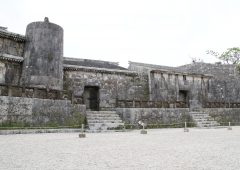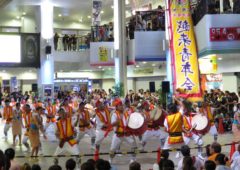2013.09.30
Kume Island has lot to offer for short trip
By Naomi Nakamatsu

A beach with naturally formed flat stones called Tatami-ishi is one of the best known spots on Kume Island.
According to a tradition, Kume Island has been known as a rice-producer in Okinawa, and this is also where derives its name from. Kume was a rice island. It is unknown when the rice making began but charred rice dated back to the 8th century has been found in caves of the island so it’s likely that the rice cultivation started much earlier.
Kume Island is about 100 km northwest from Naha, and has a population of only 8,423 people. The Kume island group consists of three other smaller islands; Ou Island (Oujima), Oha Island (Ohajima) and Tori Island (Torishima), and is the fifth biggest island in Ryukyu archipelago, and considered to be one of the most beautiful. Its emerald colored ocean and white sandy beaches are well known, of course, but the tranquility created by the combination of the well preserved traditional Okinawan houses and fukugi trees is also breath-taking. Even on Okinawa’s main island this kind of scenery does not exist any more. Here’s a short introduction of the island, and hopefully you get a chance to visit it someday.
There are a variety of products the island is famous for. For those with a sweet tooth, Miso cookies are a treat that can’t be missed. Using the Kume Island made miso (bean paste) gives the cookies a sweet and salty taste, which gets anyone hooked. Then there’s the Kuruma ebi (scampi) that many shrimp
farms on the island produce. Whether fried, boiled or raw, it will not disappoint taste buds. There’s also the well-known Kumejima Deep-sea Water Development, which produces famous Umi Budou (sea grapes, caulerpa lentillifera), sometimes called green caviar, and a variety of cosmetics made of natural ingredients. There is also Bade Haus that is a deep-sea spa & resort that combines Kume’s deep-sea water and Germany’s warm bath therapy (bade). This combination has mysterious healing powers that many islanders swear by.
Kume Island has many sight-seeing spots for visitors to see. The most famous is Tatami-ishi. a beach where naturally formed flat rocks on the shore lay in pentagonal and hexagonal shapes. They are also known as “turtleback stones”. And as a coincidence, in the past, every year sea turtles would come to this beach to lay their eggs.
There is also the Uegusuku Castle (Uegusuku-jou), from where you can view the whole island. There is a 10-15 min. climb to the spot from the parking lot, so sneakers are recommended.
Near the airport there is Goeda-no-matsu, a five-branched Ryukyu pine tree, which is about 250 years old, and extremely rare. It has been designated as one of Japan’s Natural Monuments.
Those who would like to experience a private beach, can always visit Hate-no-hama, which consists of three small, uninhabited islands made of only sand.
To some people Kume Island is also known to be the
island of love. The reason is that there are two places on the island, which symbolize the male and female. In the past newlyweds who were not able to conceive would often visit these places and pray, wishing to be given a child. Although not many people go there to pray any more, they have become tourist attractions of the island, and besides, are great fishing spots.
Kume Island is close. One can visit and enjoy the island even over a weekend. There are 5 to 7 daily flights to Kume Island from Naha Airport depending on the season. The flight time is only 20 minutes. Throughout the summer, there are also direct flights connecting Kume Island and Haneda Airport in Tokyo.
Access by ferry is a four-hour trip with two departures from Tomari Port in Naha at 8:30 a.m. and 2 p.m. A heads-up before taking the ferry ride, prior to arriving to Kume, the ferry makes a short stop at Tonaki Island, so make sure to count the hours before getting off. If you visit the island in the winter by ferry, you might have a chance to come across a humpback whale and experience a bit of whale watching.






 2024.07.12
2024.07.12 2024.07.07
2024.07.07 2024.07.02
2024.07.02 2024.06.21
2024.06.21 2024.06.11
2024.06.11 2024.06.08
2024.06.08 2024.06.03
2024.06.03 2024.05.30
2024.05.30 2024.05.25
2024.05.25






